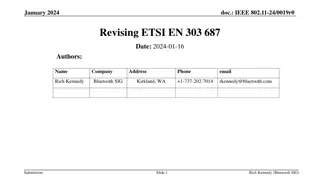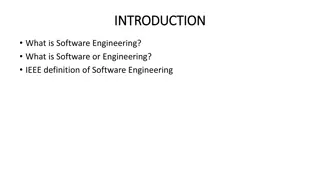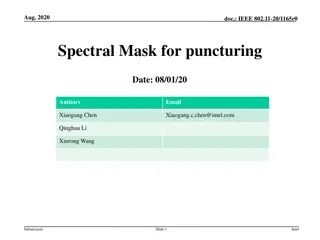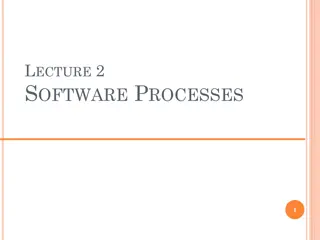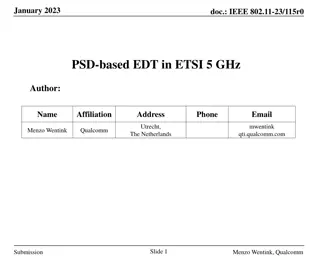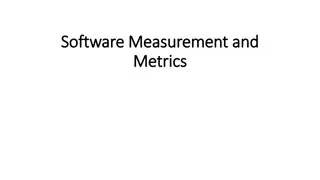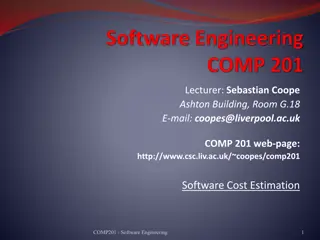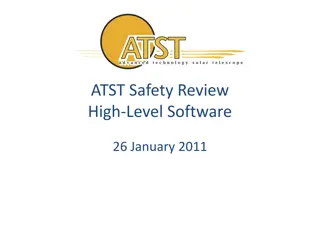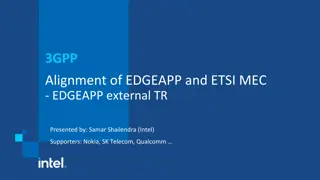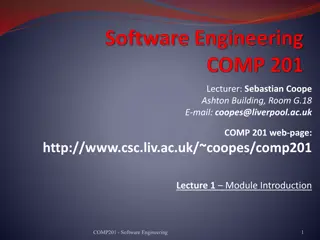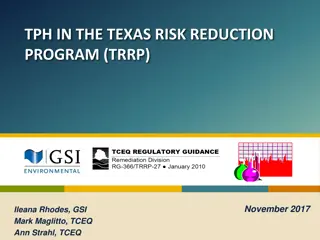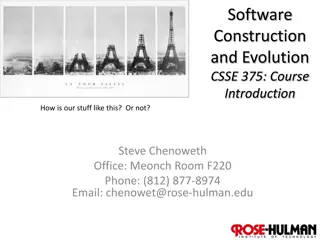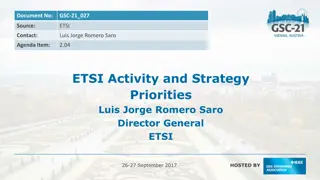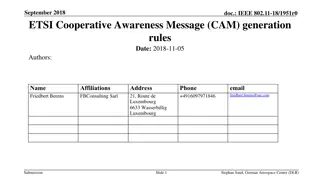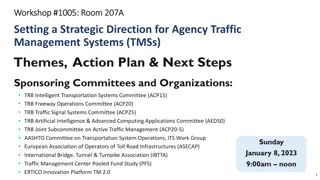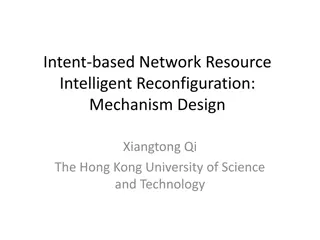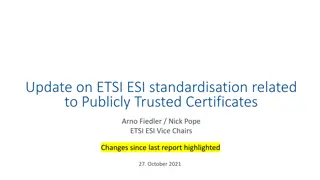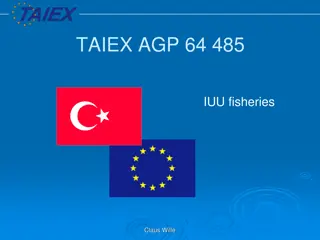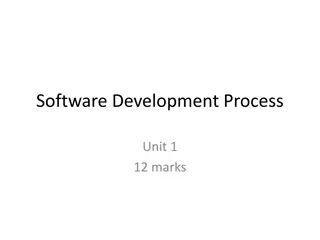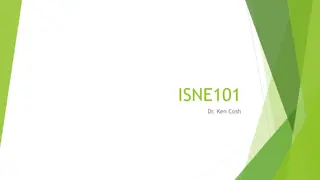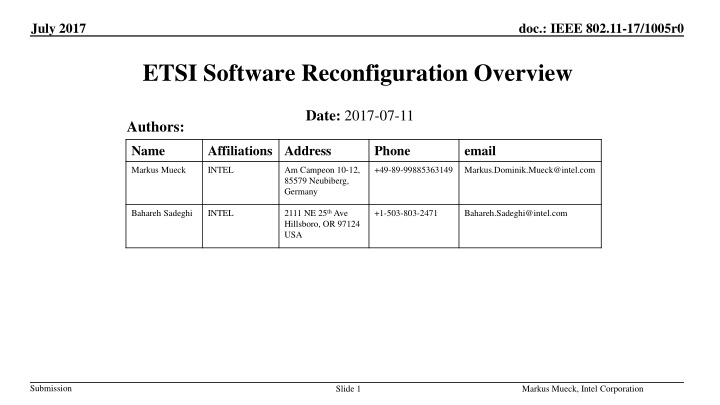
Software Reconfiguration Overview for Network Applications
Explore the overview of software reconfiguration for network applications, including motivations, use cases in automotive, IoT, and smartphones, challenges faced, and insights on past failures and future solutions. Discover the ETSI approach for efficient joint HW/SW optimization and gradual transition towards software reconfiguration.
Download Presentation

Please find below an Image/Link to download the presentation.
The content on the website is provided AS IS for your information and personal use only. It may not be sold, licensed, or shared on other websites without obtaining consent from the author. If you encounter any issues during the download, it is possible that the publisher has removed the file from their server.
You are allowed to download the files provided on this website for personal or commercial use, subject to the condition that they are used lawfully. All files are the property of their respective owners.
The content on the website is provided AS IS for your information and personal use only. It may not be sold, licensed, or shared on other websites without obtaining consent from the author.
E N D
Presentation Transcript
July 2017 doc.: IEEE 802.11-17/1005r0 ETSI Software Reconfiguration Overview Date: 2017-07-11 Authors: Name Affiliations Address Phone email Markus Mueck INTEL Am Campeon 10-12, 85579 Neubiberg, Germany +49-89-99885363149 Markus.Dominik.Mueck@intel.com Bahareh Sadeghi INTEL 2111 NE 25th Ave Hillsboro, OR 97124 USA +1-503-803-2471 Bahareh.Sadeghi@intel.com Submission Slide 1 Markus Mueck, Intel Corporation
July 2017 doc.: IEEE 802.11-17/1005r0 Overview Motivation ETSI Software Reconfiguration Solution Conclusion Submission Slide 2 Markus Mueck, Intel Corporation
July 2017 doc.: IEEE 802.11-17/1005r0 Motivation Softwarization and Virtualization are currently a network topic Virtualization such as Network Function Virtualization Software Defined Networking Mobile Edge Computing Etc. Observation: A similar discussion is not (yet) ongoing for the client (terminal) side Questions: Are there client-centric use cases for which Software Reconfigurability may provide added value? Why did it not work out in the past? Which are critical design requirements and existing solutions? Submission Slide 3 Markus Mueck, Intel Corporation
July 2017 doc.: IEEE 802.11-17/1005r0 Use Cases ETSI is issuing a Software Reconfiguration White Paper focusing on three Use Cases: Automotive applications Challenge: Lifetime of communication components is substantially longer (> 10 yrs) compared to Smartphones (~ 2 yrs), etc. Requirement: How to resolve vulnerabilities which may come up over the lifetime of a vehicle (>10 years) IoT Challenge: A substantial number of different IoT applications exist, it is challenging to provide a dedicated chipset solution for each case. Requirement: How to enable a generic chipset platform to be tailored to a specific IoT application through SW Reconfiguration? Submission Slide 4 Markus Mueck, Intel Corporation
July 2017 doc.: IEEE 802.11-17/1005r0 Use Cases Mass Market Smartphones and similar Challenge: Smartphone Apps are not able to alter radio characteristics of a client device due to certification issues, etc. Requirement: To define an ecosystem (comprising technical, security and regulation solutions) to extend the existing App eco-system to Radio-Apps which are apple to (selectively) alter radio parameters. Submission Slide 5 Markus Mueck, Intel Corporation
July 2017 doc.: IEEE 802.11-17/1005r0 Why did Software Reconfiguration fail in the past for commercial mass-market devices? Efficiency Past approaches were mainly building on a middle-ware approach In commercial mass market products, however, the main source for efficiency lies in the joint optimization of HW/SW. A middle-ware limiting designers with respect to power efficient solutions. Conclusion: The ETSI approach allows for code portability while maintaining joint HW/SW optimization through a Radio Virtual Machine (RVM) approach. Gradual transition towards SW Reconfiguration Past approaches were requiring a too big step from manufacturers, moving from ASIC solutions to full SW implementations Conclusion: The ETSI approach allows for a gradual approach, e.g. replacing ASIC component in case of vulnerabilities being identified. Submission Slide 6 Markus Mueck, Intel Corporation
July 2017 doc.: IEEE 802.11-17/1005r0 Gradual Reconfiguration Approach EN 303 146-4: Radio Programming Interface Submission Slide 7 Markus Mueck, Intel Corporation
July 2017 doc.: IEEE 802.11-17/1005r0 The ETSI SW Reconfiguration Eco-System EN 303 095: Software Reconfiguration Architecture Submission Slide 8 Markus Mueck, Intel Corporation
July 2017 doc.: IEEE 802.11-17/1005r0 SW Reconfiguration Efficiency through Radio Virtual Machine approach, EN 303 146-1/2/3/4 Radio Virtual Machine Approach Submission Slide 9 Markus Mueck, Intel Corporation
July 2017 doc.: IEEE 802.11-17/1005r0 Interfaces defined by ETSI Interfaces are defined in EN 303 146-1/2/3/4 Multiradio Interface (MURI) Administrative Services Access Control Services Data Flow Services Unified Radio Application Interface (URAI) Radio Application Management Services User Data Flow Services Multiradio Control Services Radio Programming Interface (RPI) Reconfigurable RF Interface (RRFI) Spectrum Control Services Power Control Services Antenna Management Services Tx/Rx Chain Control Services RVM Protection Services Submission Slide 10 Markus Mueck, Intel Corporation
July 2017 doc.: IEEE 802.11-17/1005r0 Certification Approach ETSI TR 102 967: Following discussions with regulation administrations, the approach is to have a single responsible entity ( Conformity Contact Entity ) for the combination of HW and SW Provision of orginal HW and certificate when device is sold Original Equipment Manufacturer Usage of new SW component Provision of new SW component and (pointer to) SW certificate or (pointer to) updated device certificate RadioApp Store Interaction on HW compliance issues Accepts the overall responsibility and liability for the conformity Conformity Contact Entity Software Manufacturer(s) Interaction on SW compliance issues Interaction on compliance issues (HW/SW) Interaction on SW compliance to Operator s Network National Regulatory Authority Service Providers Submission Slide 11 Markus Mueck, Intel Corporation
July 2017 doc.: IEEE 802.11-17/1005r0 Security Solutions Security mechanisms defined in ETSI TR103 087, TS103 487 Proof of the integrity of the Radio Applications, RE Configuration Policy and Declaration of Conformity; Proof of the identity of the developer of Radio Applications, the issuer of the RE Configuration Policy, and the issuer of the Declaration of Conformity; Prevention of an asset installation when the asset is not provided by a legitimate actor; Use of the reconfiguration feature as a security update mechanism; Proof of conformance of the radio platform and radio application to the regulatory Declaration of Conformity, considering that the set of installed radio applications can change over time; Prevention of illegitimate use of the Declaration of Conformity (in particular against counterfeit); Submission Slide 12 Markus Mueck, Intel Corporation
July 2017 doc.: IEEE 802.11-17/1005r0 Security Solutions Security mechanisms defined in ETSI TR103 087, TS103 487 Audit functionalities including a non-repudiation framework and remote attestation; Long-term management framework (e.g., transition of equipment responsibility from one manufacturer to another); Prevention of masquerade of stakeholders in the RRS value chain; Prevention of code theft; and, Supply chain integrity and assurance (which underpins all of the above measures). Submission Slide 13 Markus Mueck, Intel Corporation
July 2017 doc.: IEEE 802.11-17/1005r0 Conclusion ETSI EN 303 095 and EN 303 146-1/2/3/4 provide a framework for Software Reconfiguration including technical, security and regulation solutions New Working Items have been agreed at last ETSI RRS meeting to extend the solution to Wireless Equipment in general In Europe, the European Commission is in the process of setting up an Expert Group for implementing articles 3(3)(i) and 4 of the Radio Equipment Directive (RED) related to Software Reconfiguration The ETSI SW Reconfiguration Framework may be applied to any type of wireless technology client devices and client technology it may thus support IEEE 802.11 equipment over its lifetime. Submission Slide 14 Markus Mueck, Intel Corporation
July 2017 doc.: IEEE 802.11-17/1005r0 References [1] ETSI EN 302 969 V1.2.1 (2014-11), Reconfigurable Radio Systems (RRS); Radio Reconfiguration related Requirements for Mobile Devices [2] ETSI EN 303 095 V1.2.1 (2015-06), Reconfigurable Radio Systems (RRS); Radio Reconfiguration related Architecture for Mobile Devices [3] ETSI EN 303 146-1 V1.2.1 (2015-11), Reconfigurable Radio Systems (RRS); Mobile Device Information Models and Protocols; Part 1: Multiradio Interface (MURI) [4] ETSI EN 303 146-2 V1.2.1 (2016-06), Reconfigurable Radio Systems (RRS); Mobile Device (MD) information models and protocols; Part 2: Reconfigurable Radio Frequency Interface (RRFI) [5] ETSI EN 303 146-3 V1.2.1 (2016-08), Reconfigurable Radio Systems (RRS); Mobile Device (MD) information models and protocols; Part 3: Unified Radio Application Interface (URAI) Submission Slide 15 Markus Mueck, Intel Corporation
July 2017 doc.: IEEE 802.11-17/1005r0 References [6] ETSI EN 303 146-4, to appear, Reconfigurable Radio Systems (RRS); Mobile Device (MD) information models and protocols; Part 4: Radio Programming Interface (RPI) [7] ETSI TR 103 087 V1.1.1 (2016-06); Reconfigurable Radio Systems (RRS); Security related use cases and threats in Reconfigurable Radio Systems [8] ETSI TS 103 436 V1.1.1 (2016-08); Reconfigurable Radio Systems (RRS); Security requirements for reconfigurable radios [9] ETSI TR 102 967: Reconfigurable Radio Systems (RRS); Use cases for dynamic equipment reconfiguration, V1.2.1, 2015 Submission Slide 16 Markus Mueck, Intel Corporation

